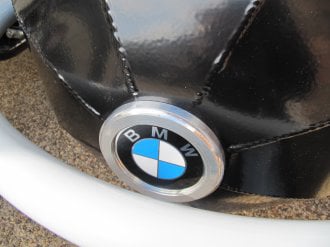
Building the Sidecar Bodywork
The sidecar bodywork was made from 1.5mm thick aluminium panels laser cut, pinned and welded together; and then re-enforced as necessary.

The sidecar bodywork was made from 1.5mm thick aluminium panels laser cut, pinned and welded together; and then re-enforced as necessary.

The body was made from 4 panels.
The top panel (shown on the right)formed both sides of the sidecar cabin and 5 of the 8 nose sections.
The base panel was longer so that the back could be folded up to form the boot section.
There were also 2 lower quarter panels. These would need to be twisted to make the transition from the square rear section to the octagonal front section.

A wooden former was made up as shown, to curve the front panels. The final radius of the former was established by trial and error, to allow for the elasticity of the metal.
The final radius of the metal was 250mm, but the former needed was 160mm radius.

Initial panel forming.

A badge mounting was designed to take a 70mm BMW tank badge and was also drilled to hold the tip of each of the nose sections.
Each panel was aligned behind the badge mounting and then clamped, drilled and held in place with an M3 screw and nut.

At the back a similar wooden former was used to fold up the boot section.
This time the final radius of 100mm required a 70mm radiused former.

The bottom panel and boot section were secured to the side panels using more M3 screws and nuts through the flanges already in place on the bottom panel.

The twisted quarter panels were held at the back edge with some panel clamps and then progressively twisted and screwed into place.
Some filing was necessary to get a nice fit around the nose section.

With the general profile of the body now established, it was positioned in the frame to check for clearances and alignment.

A universal rear motorcycle mudguard was modified to have a side plate.
The mudguard came from Feked classic bike parts.

To strengthen the bodywork. Box section aluminium was riveted across the base to take the load from the seat.
Aluminium angle was added to each side of the seat area to strengthen the sides and also give a surface for the passenger to lift themselves out of the seat.
Another box section was added across the back to take the proposed upper seat belt mountings.

On the underside of the body, two angle aluminium rails were riveted along the length to strengthen the floor.
Three rubber buffers were used to transfer the weight of the seated passenger down to the frame. These buffers were 50mm tall and they were selected to centre the bodywork within the height of the frame.

The welder also helped make a support arch for the front bonnet section of the sidecar.
This was made from more aluminium angle mitred to be an exact fit in the bodywork and riveted into place.

A 19" steel mudguard from Feked Classic Bike Spares was modified to cover the inside of the sidecar wheel.
Some 2mm thick steel was cut to sit inside the lip of the mudguard part.
Is was then tack welded and finally seam welded into place.

A steel bracket was made up to take a brake/tail light assembly. The light was a copy of the classic Lucas 564 tail light.

To profile the mudguard side plate around the frame, it was clamped in place and a line drawn against the frame. To ensure enough clearance for the wheel under all conditions, the suspension was compressed with a ratchet strap to locate the final position of the mudguard.

This image shows the parts ready to go to the paint shop.
The chosen finish was a powder coat in satin black.

Here is the body back from the paint shop....

.....the painted mudguard.....

.....and the finished badge assembly.

The build so far.
HTML Code Generator